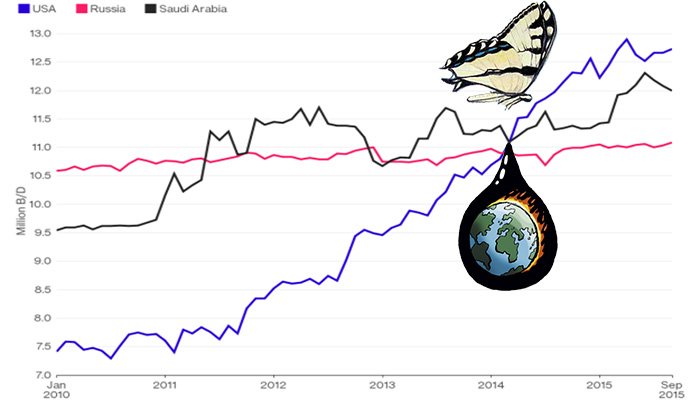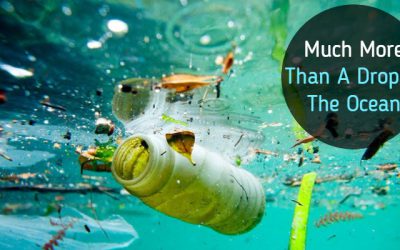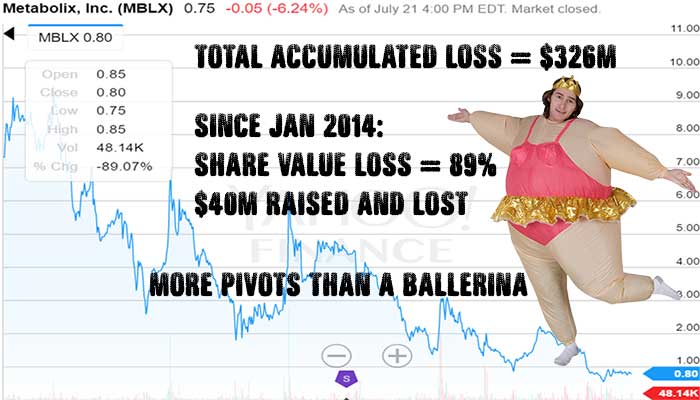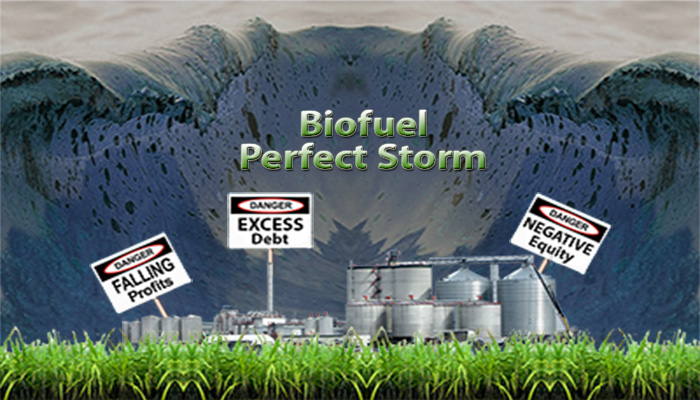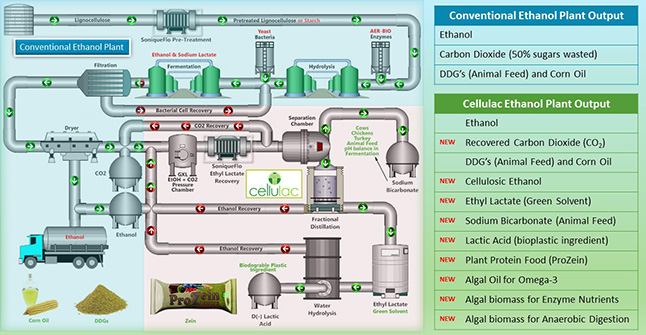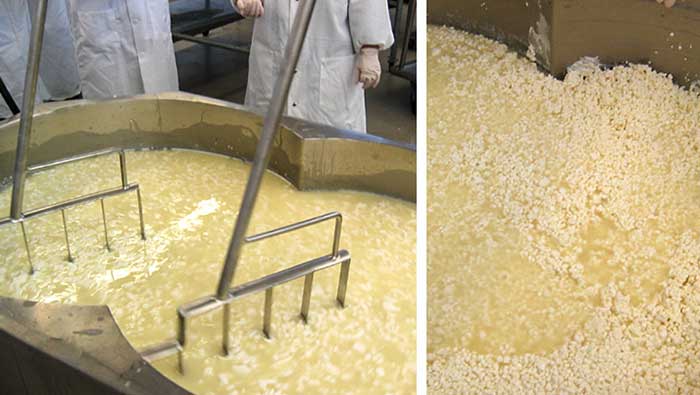Butterfly Effect of Oil Price on Renewables
The butterfly effect is a concept that small causes can have large effects. Initially, it was used with weather prediction but later the term became a metaphor used in and out of science. Now it can easily be related to a single decision made by a Saudi Oil Minister.
Parallel Oil Worlds
I read articles on the bioeconomy referring constantly to the “need” to replace fossil fuels, sometimes in amazement, wondering if there are two parallel worlds. I listened to Saudi Oil Minister, Ali Ibrahim Al-Naimi, telling the world that the freezing of oil production at January 2015 levels is merely part of a process. The objective is to force U.S. high cost shale oil producers to shut down, even if Saudi have to produce at $20 per barrel. His direct comment: “It sounds harsh, and unfortunately it is, but it is the most efficient way to rebalance markets”.
Henri Colens, Public Affairs Manager, Renewable Chemicals, at Braskem Europe, mentioned in an interview with Il Bioeconomista that “we all need to work harder on raising public awareness, so that citizens understand what we are doing and the potential of the bioeconomy”.
Oil Power beats Citizen Power
The power of citizens it seems are over shadowed by the flapping of an oil ministers wings when it comes to the biochemical and biofuel market.
Saudi Arabia, Russia, Qatar and Venezuela proposed a freeze that would cap production at January levels. The same day Iran called the proposal for a freeze ridiculous as they began their production of 1 million barrels per day. When the price of oil collapsed to below $50 a barrel in March of 2015, Saudi Arabia and Iraq began to increase production. Since February 2015 Iraq and Saudi have increased production over 1.3 million barrels per day.
Butterfly cascade after one decision
The cost of oil reduces the cost of refining to gasoline which in turn is blended with ethanol. When it drops so low that ethanol is more expensive than gasoline production, demand falls and high cost producers of ethanol suffer serious margin erosion. Citizens are happy as pump prices are lower, but the butterfly effect starts to hit more than shale oil.
Sovereign wealth funds who amassed wealth while oil prices were higher would have invested in growth of the world economy. Now many of them, including Saudi Arabia, Norway and other oil producers are dipping into their funds to balance their fiscal budgets. Russia being one that is suffering on a number of levels with economic sanctions and low oil prices. This leaves little discretionary investment funds for the bioeconomy who are still far from sustainable profitable businesses, leaving little support other than State or Federal supports.
So far from cellulosic ethanol
In 2010-2011 of the five biofuel companies who listed on NASDAQ today only one is still focused on fuel and constantly diluting their shareholders while others are searching for lower volume, higher value added, biochemicals. The search for cellulosic ethanol sees pilot plants such as Abengoa Hugoton achieving costs of $4.55 a gallon of ethanol. Considering the oil price no wonder this has been closed.
The point is that biofuel, or indeed the bioeconomy overall, requires that oil prices are much higher just to survive, both to compete on price, but also to have profits in the petrochemical companies available for investment in these alternatives.
Is Petro-Biofuel hybrid evolution enough?
There are a few hybrids. Braskem, as mentioned above, and Croda International PLC who posted a 10% increase in pre-tax profits where they use 70% renewables such as palm oil to produce ingredients for cosmetics and paint. Although in existence since 1925, they are a good example of how renewables are a work in progress over a timeframe that requires the patience of an evolution rather than the desperation of a revolution. The question is whether the citizens of planet earth have the time to evolve from the oil wars to survive the climate change.
[TheChamp-FB-Comments style=”background-color:#f7f7f7;” title=”Leave a Comment”]
Integumen License Ageement
Today, Cellulac announces that it has signed Heads of Terms to enter into a commercial technology agreement with Integumen (LSE: SKIN). In addition, Integumen has conditionally agreed to acquire 9.35% of the issued shares of Cellulac. Gerard Brandon and Camillus...
What are you doing about ocean pollution?
To many people watching Sky News and their #OceanFree Campaign, you would think that removing plastic from the oceans will be enough to resolve the problem. Sadly, this is not the case. The oceans ability to provide food from fisheries and aquaculture is...
Climate Change Our Bit Infographic
[TheChamp-FB-Comments style="background-color:#f7f7f7;" title="Leave a Comment"]
Biomassive Revolution
It's just not your fault What if I were to tell you that it is not your fault that the seas are polluted with plastic that the fish and whales are consuming? In the same way, I can say that it is not your fault that over-fishing is destroying future fish...
Daring to Dream Big
The definition of insanity is doing the same thing over and over again and expecting a different result - Albert Einstein Another 300 million tonnes of plastic every year Since World War II we have consumed 5 billion tonnes of plastic, much of which has ended...
Low Energy Microalgae to Biofuel at Commercial Scale
Food and Fuel for the 21st Century Microalgae have come to the attention of the industrial and academic community over recent years because of their ability to harvest the energy of the sun and provide valuable molecules that offer great potential to provide...
Cellulac Formally Requests Metabolix Shareholders to Consider Merger Proposal
Cellulac merger proposal to Metabolix worth $40m in assets and offtake agreement of $38m rejected in favor of closing biopolymer business and spending $35m over 7 years on crop science project with no revenue. DEAR METABOLIX SHAREHOLDERS London, UK. 25th...
Extracting real value from the Ethanol Industry
Hybrid Solutions There is no need to reinvent a billion dollar wheel of bio-industrial experimental development. True value can be extracted and integrated as hybrid synergistic solutions from the best-in-class of what already exists. Over the last 10...
Have we Reached Peak Biofuel?
Is there really an energy security risk? Former NATO Secretary General Anders Fogh Rasmussen is calling on Europe to increase the production of biofuels from an energy security perspective because of geopolitical risks. This is a tough ask if such increase in...
Biofuels Perfect Storm
Biofuels Perfect Storm Since August 2015, ethanol has traded at a premium to gasoline which is unusual by historical standards. This is likely to continue until oil prices rebound into the $45-50 per barrel range. Even with this situation, 2015 ethanol...
Ethanol Industry is not too big to Fail
Phonetically speaking we know the two things that are guaranteed are death and taxes. However debt can be the precursor to death for not just companies, but industries. The ethanol industry, reading through the last 2 years of SEC filings by ADM, indicate that...
High Corn Crush Margin Ethanol Plant Solution
The ethanol industry has only been around for the last few of decades, though in its present state it takes centuries of fermentation knowledge to achieve the same output of ethyl alcohol (ethanol).Today, there are by-products or side-streams, such as distilled...
Corny Problem for EU Sugar Producers
The abolition of sugar quotas in 2017 will have such a profound effect on EU sugar producers, used to super profits under the EU supported Common Agricultural Policy (CAP), that many smaller producers will be subject to consolidation or have to cease...
Big Oil Can’t Alter Climate Change
In a recent major MIT Study (Covert, Thomas, Michael Greenstone, and Christopher R. Knittel. 2016. "Will We Ever Stop Using Fossil Fuels?" Journal of Economic Perspectives, 30(1): 117-38. ) it was shown that approximately 65 percent of global greenhouse gas...
Cellulac Acquires Aer Sustainable Energy (Aer-Bio)
10 fold saving in enzymes, 4 fold increase in algae oils within 2 hours reducing the process costs of Omega-3, animal feed and biofuels Dublin, Ireland, 18th May 2015: Cellulac, the industrial biochemicals company, today announces the acquisition of Aer...
5 year, €35m Pharmafilter Partnership with Cellulac
Partnership delivers 2nd generation bioplastics supply chain solution for hospitals Dundalk, Ireland and Amsterdam, The Netherlands, 30th March 2015: Cellulac, the industrial biochemicals company, and Pharmafilter, a provider of integrated waste management...
Lactic Acid from Lactose Whey in World First Continuous Production runs
Cambridge, UK. 19 May 2014: Cellulac, the industrial biochemicals company is delighted to announce the world’s first ever industrial level continuous production of lactic acid from deproteinized lactose whey. Our 10 day production run concluded this week and...
Cellulac to Acquire Patent Portfolio and Industrial Biochemical Equipment from Pursuit Dynamics PLC
Cellulac Limited, the industrial biochemicals company, announces the acquisition of Pursuit Marine Drive Limited, a subsidiary of Pursuit Dynamics PLC, subject to shareholder approval. The acquisition includes certain intellectual property rights, test...

